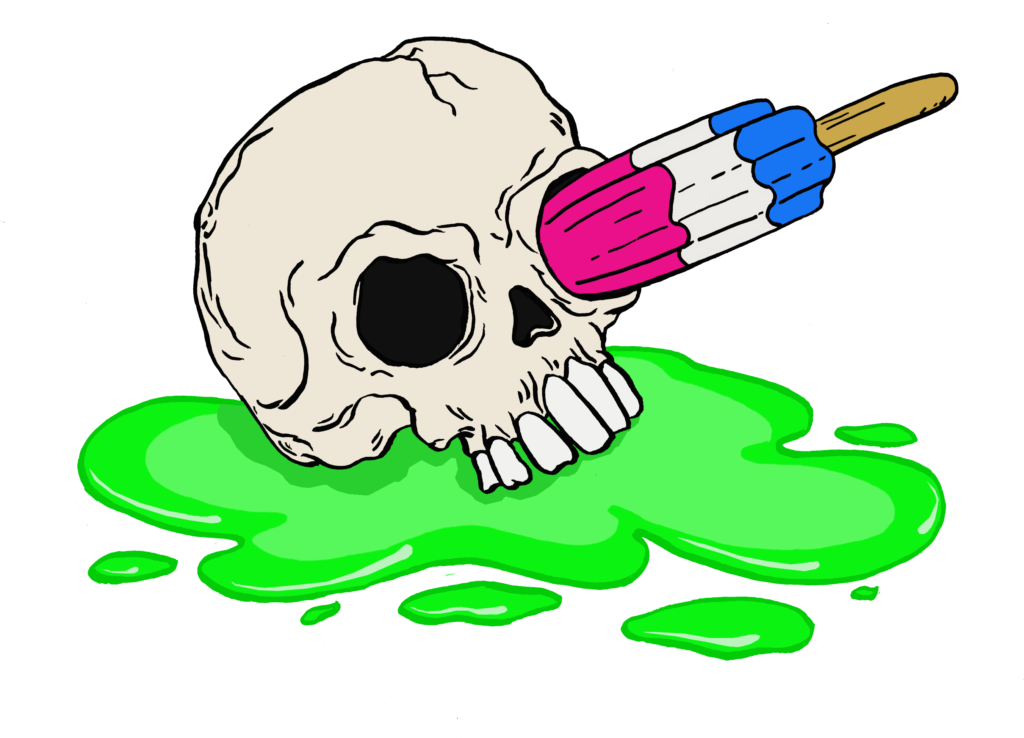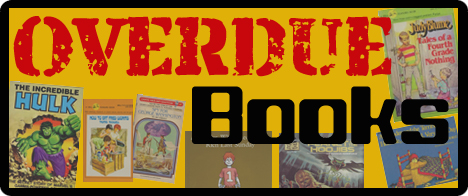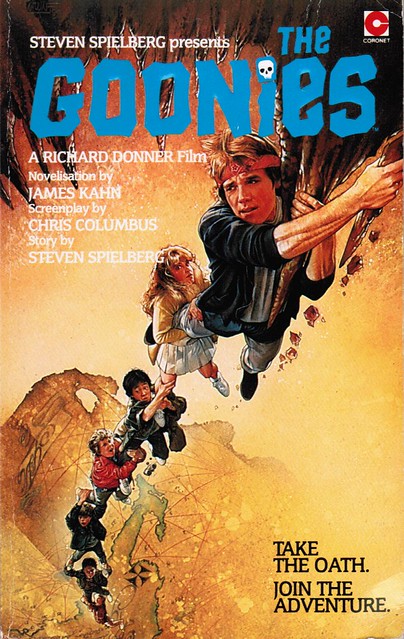I’ve talked before about my love of souvenir movie magazines and novelizations of 80s flicks because they were a great source of obscure information and deleted content from a lot of the films I grew up loving. Back before DVD and the internet, which provides such easy access to deleted scenes or behind the scenes commentary and the like, it was really hard to track down more about movies like The Goonies, Karate Kid, or the first Batman flick. So when you were the only one of your friends that happened to catch a screening Batman in the theater and you remembered a scene with a little homeless girl in a trash pile and no one believed you because that scene was edited out of the theatrical cut for the VHS release, well, you had your work cut out for you in proving it.
Over the last few years I’ve been picking up cheap copies of souvenir magazines and movie novelizations when I can find them. Lately I’ve been lucky enough to stumble upon a bunch of these 80s novelizations and I thought it would be fun to pull one out of the pile from time to time to share what insights or differences these offer from the versions of the films that we know and love. I had a lot of fun when I read the E.T. novelization by William Kotzwinkle, and I’m hoping more of these books were written with the same sort of changes in perspective that open me up to experiencing the flick with a fresh set of eyes. Real quick, I’d like to point out that I’m going to concentrate on novelizations, books based on screenplays, and not movies that were adapted from existing novels. For one it narrows the field a bit, and it pretty common for film adaptations to excise material from the original books because of time and pacing considerations.
This week I thought I’d take a look at one of the harder books to track down, the novelization of the Goonies by James Kahn (adapted from the Chris Columbus screenplay.)
I say it’s hard to track it down, but mainly I’m referring to copies of the book that were printed here in the US by Warner Bros. The book was also printed in the U.K. by Coronet in 1985, and from what I can tell there is no real differences it the text except an odd Britishism here and there (I compared it to a snippet of the American edition available on Google Books), and some minor differences in the cover blurbs. My UK edition simply states, “Take the Oath. Join the Adventure.”, whereas the US edition is a lot more wordy. Anyway, the UK edition is more or less readily available on ebay, and lately with the exchange rate equaling out it’s kind of a bargain.
Upon cracking the cover and diving into the book the first main difference that I noticed is that the book is presented in a slightly odd format. The text is bookended by excerpts from local Astoria newspaper articles, first detailing the escape of Jake Fratelli, and later covering the “rescue” of the kids, the arrests and prosecution of the Fratelli gang, and some other interesting footnotes to the story I’ll get into in a minute. The main reason for this is that for the bulk of the book Kahn chose to use Mikey as the narrator with a first person perspective. If I had to guess I’d say that this was in an attempt to make the novel more approachable for kids, but it ends up making the whole thing very difficult to read. First person is a tricky perspective, and when adapting an omniscient film experience it forces the narrative to constantly explain why the narrator knows about sequences that they didn’t take part in or know little about. Thus the newspaper articles are Mikey’s way of opening the story with the facts of the breakout and the ensuring police chase. What killed me is how dry this approach came off, lacking any of the humor and excitement that was in the opening scenes of Donner’s film. Not only that but some little details are lost, most importantly how the chase manages to cross the paths of all the Goonies, Andy and Steph. Not a huge deal, but it’s a detail I love in the first film as it both introduces us to the characters and gives some background details on each of them (Mouth’s dad being a plumber, Steph’s family working as fishermen on the docks, and Chunk being a spaz to name a few.)
On the other hand, the “articles” that close out the story are kind of interesting. For one, they take the ending of the movie a bit further in that there is confirmation, through a series of excerpts, that the Goon docks are safe as the plans for the new golf course are ditched in favor of building more low cost housing. The already constructed country club was even rumored to be converted into a community center that will feature a children’s center, a Chinese restaurant, a plumbing supply house, a fish market, a new addition to the museum, and a public-access invention laboratory. A little goofy, but still pretty darn cute. The last article is a notice of the Bar Mitzvah for Jason “Sloth” Cohen, the newly adopted son of Mr. & Mrs. Jerry Cohen. So I guess Chunk made good on his promise to have Sloth come live with him…
As for the narrative being from the perspective of Mikey, this is also a little 50/50 in terms of execution and insight. On the plus side, it’s kind of fun to “hear” him tell the story, as he adds some background (most of it pointless, but still fun) and adding his thoughts on every aspect of the adventure. He makes a metric ton of Star Wars references (probably infused because Kahn also wrote the Return of the Jedi novelization), which is always fun, as well as playing the cool, level-headed leader of the group while describing each of the Goonies and their various quirks, annoying habits, and strengths. He even ends up explaining some of the subtle references that made it into the performances in the final film (like when Mouth first comes to the Walsh house and starts trying to cheer the brothers up with a slight John Belushi impression.) At the same time Kahn has him hating Saturday morning cartoons (I guess he’d rather be outside adventuring), already dating (and smooching girls before Andy), and comparing the Mad magazine “fold-in” concept to the Playboy centerfolds, which is just weird. Again, the danger of writing in the first person like this is that we’re in Mikey’s head, and being inside there is nothing like what I thought it would be in the movie. Granted, I know we’re really inside Kahn’s head, but you get my drift.
Anyway, some of the slight differences in the book include Mouth’s propensity for rhyming, Data pulling out inventions three times as much, and Mikey tending to censor some of the racier jokes and sight gags from the film with his descriptions (remember the broken stature of David, well Mikey didn’t want to repeat Brand saying that, “…If God made it that way, you’d all be pissing in your faces…”.) By the by, in the book Mikey’s mom discovers the broken statue. There’s also some interesting cross-pollinating with other Spielberg projects like Poltergeist. At one point Mikey shares and anecdote about how he broke his arm falling into an excavation in the newly built Cuesta Verde Estates housing development. Did I mention that James Kahn also wrote the novelization for Poltergeist? The thought that, Cuesta Verde would be within biking distance from Astoria is pretty cool, as if there really was this specific Spielberg suburbia out in the pacific northwest where all kinds of crazy shit happened. Maybe E.T. would have landed there too if that novelization hadn’t already been written by Kotzwinkle.
Also, for all those kids out there that only caught the Goonies when it aired on cable (specifically the Disney Channel in the early 90s), the book provides vindication of some of the deleted scenes that appeared in that cut of the film. I always thought it was weird that there were so many different versions of flicks in the 80s, one for theaters, one for vhs, one for cable, one for airline exhibitions, etc. Deleted scenes sort of meant more then, as they were potential filler for some of the other raunchier stuff that needed to be cut for cable. Anyway, I was one of those kids that saw the octopus scene, and the segment at the beginning when Mikey, Data, Chunk and Mouth have a run in with Troy in the minimart when the flick aired on the Disney channel, and later when watching the official VHS with friends none of them believed me that these scenes existed. Can’t express how happy I was to see them finally pop up on the DVD. There are also a couple of extensions of the wishing well scene. One involves Andy being inducted as an official Goony by repeating the oath: “I will never betray my Goon dock friends, We will stick together until the whole world ends, Through Heaven and Hell and nuclear war, good pals like us will stick like tar, In the city, or the country, or the forest, or the boonies, I am proudly declared a fellow…” The oath is finished off with the exclamation of “Leech!” as Mikey realizes they’re all covered in leeches. These scenes were new to me when I ready the youth adaptation of the movie back in 2010 during my Goonies 25th anniversary week. Glad to see them in this full on novelization as well.
I don’t want to spoil all the good stuff from the novel that didn’t make it into the film, but there’s one more segment that’s really cool involving an underground river. While the gang is trying to find their way to One-Eyed Willie’s ship, they come upon a cave with only one exit, which is almost completely submerged in water. There’s a raft, so they all get on as they hear the Fratelli’s hot on their trail. Along the ride they all take turns telling stories to keep each other from freaking out in the dark water-filled tunnel. Again, nothing that needed to be in the film, but it’s really fun to stumble upon an extra like this in the book. All in all I think this one is worth the read, even though the first person narrative is awkward. It’s a great way to spend a little more time with the gang while getting some new aspects to the adventure along the way. If nothing else it has me really jazzed to read the Three Weeks with the Goonies book by Mick Alderman. I can never get enough of this flick!
***UPDATE***
Okay, so there was one other thing that I wanted to point out about the book, one small segment of a scene that was cut from the film involving the leeches. I wasn’t sure I wanted to mention it because it’s kind of messed up, but I thought about it and I can’t help it, it’s just too damn weird. So in the wishing well sequence, at the end, after Andy has sent up the bucket empty, all the kids realize that they’re covered in leeches. Data has a bright idea and end up strapping two wires to a 20-volt battery. He sticks the wires in the water by his feet sending a light electrical charge through his body that’s lethal enough to kill the leeches. He does this for the rest of them, and afterwards, James Kahn tags on a small scene that is, well, almost obscene. After getting the shock, Andy and Stef are standing off to the side, and Kahn describes them as having “…limp smile(s) and small sigh(s)…” Then Stef says to Andy, “I got all tingly – just my luck, I’m in love with a pond!” After which the following passage appears: ‘It annoyed Andy, for some reason, I don’t know, like someone had made her feel good and she didn’t want to…’ Then Andy hauls off and slaps Data saying “Don’t-you-ever-try-that-again-with-me-Buster!” What the hell! Did Kahn actually suggest that Andy and Stef had orgasms from the electric shock!?! W-T-F?!?



